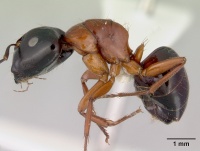Camponotus armstrongi
| Camponotus armstrongi | |
|---|---|

| |
| Scientific classification | |
| Kingdom: | Animalia |
| Phylum: | Arthropoda |
| Class: | Insecta |
| Order: | Hymenoptera |
| Family: | Formicidae |
| Subfamily: | Formicinae |
| Tribe: | Camponotini |
| Genus: | Camponotus |
| Species: | C. armstrongi |
| Binomial name | |
| Camponotus armstrongi McAreavey, 1949 | |
Photo Gallery
Identification
Keys including this Species
- Key to Australian Camponotus majors of the southwestern Botanical Province
- Key to Australian Camponotus minors of the southwestern Botanical Province
- Key to Australian Camponotus species
Distribution
Latitudinal Distribution Pattern
Latitudinal Range: -31.5652° to -36.91666667°.
| North Temperate |
North Subtropical |
Tropical | South Subtropical |
South Temperate |
- Source: AntMaps
Distribution based on Regional Taxon Lists
Australasian Region: Australia (type locality).
Distribution based on AntMaps
Distribution based on AntWeb specimens
Check data from AntWeb
Countries Occupied
| Number of countries occupied by this species based on AntWiki Regional Taxon Lists. In general, fewer countries occupied indicates a narrower range, while more countries indicates a more widespread species. |

|
Estimated Abundance
| Relative abundance based on number of AntMaps records per species (this species within the purple bar). Fewer records (to the left) indicates a less abundant/encountered species while more records (to the right) indicates more abundant/encountered species. |

|
Biology
Castes
Images from AntWeb
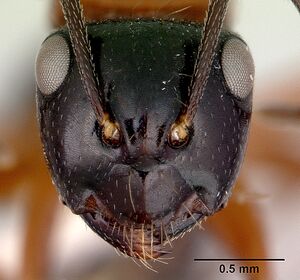   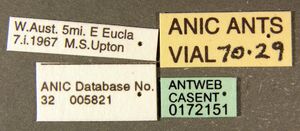
| |
| Worker. Specimen code casent0172151. Photographer April Nobile, uploaded by California Academy of Sciences. | Owned by ANIC, Canberra, Australia. |
  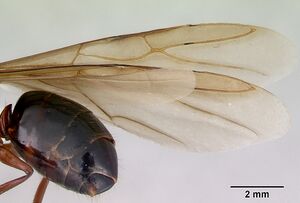  
| |
| Queen (alate/dealate). Specimen code casent0172152. Photographer April Nobile, uploaded by California Academy of Sciences. | Owned by ANIC, Canberra, Australia. |
  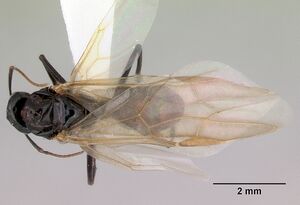 
| |
| Male (alate). Specimen code casent0172153. Photographer April Nobile, uploaded by California Academy of Sciences. | Owned by ANIC, Canberra, Australia. |
Nomenclature
The following information is derived from Barry Bolton's Online Catalogue of the Ants of the World.
- armstrongi. Camponotus (Myrmogonia) armstrongi McAreavey, 1949: 19, figs. 53-56 (s.w.) AUSTRALIA (New South Wales).
- Subgenus indeterminate: Ward, et al. 2016: 351.
- Status as species: Taylor & Brown, 1985: 110; Taylor, 1987a: 11; Bolton, 1995b: 86; McArthur, 2007a: 337; Heterick, 2009: 68; McArthur, 2010: 60; McArthur, 2014: 120.
Type Material
- Camponotus (Myrmogonia) armstrongi McAreavey, 1949: Holotype, worker, Nyngan, New South Wales, Australia, Australian National Insect Collection.
- Camponotus (Myrmogonia) armstrongi McAreavey, 1949: Paratype, 2 major and 4 minor workers, Nyngan, New South Wales, Australia, Museum of Comparative Zoology.
- Camponotus (Myrmogonia) armstrongi McAreavey, 1949: Paratype, 3 workers, Nyngan, New South Wales, Australia, National Museum of Natural History.
Unless otherwise noted the text for the remainder of this section is reported from the publication that includes the original description.
Description
Worker major. Length, 6-8 mm. Head and gaster shining black, with the antennae slightly lighter and the articulation of the scape yellowish; thorax, node and legs, except the tarsi and the apex of the tibiae, bright brownish red; apex of tibiae and the tarsi more brownish. Head, thorax, node and gaster very finely and densely striate transversely, finer on the gaster which is shining and almost smooth in parts. The striae are joined together to form a wide meshed reticulation. There are also a few scattered punctures on the front of the head. Hair yellowish, long, sparse on the head and thorax, more abundant on clypeus, node and gaster. Head rectangular, one-third longer than broad, with the sides almost straight, the occipital border straight and the posterior angles abrupt. Mandibles furnished with four strong, sharp, teeth; clypeus large, feebly keeled, the anterior border rounded and faintly crenulated in center; frontal groove distinct, reaching to the end of the frontal carinae. Scape reaches just beyond the occiput; first segment of funiculus longer than second, all segments twice as long as broad; eyes moderately large, rather flat, placed at the posterior third of hard; no occelli but there is a slight pit in place of the anterior occellus. Thorax nearly twice as long as the broadest part, which is at the pronotum; pronotum one and a half times as broad as long, rounded in front, with feebly convex sides. One the front of the pronotum is a sharp semicircular ridge or margin which extends some way back along the sides. Pro-mesonotal suture is distinct; mesonotum broader than long; meso-epinotal suture feebly marked. The meso-epinotum is nearly twice as long as broad in front, compressed laterally behind so that the dorsum at the epinotum is reduced to a sharp ridge. In profile the whole dorsum of the thorax forms a single strong convexity, with the pronotal region slightly flattened. The epinotal (=propodeal) declivity is feebly concave with the stigmata near the base very distinct. Node twice as broad as long, elliptical. In profile thorn-like, twice as high as long, the anterior face convex, merging into the dorsum. The apex is sharp and the posterior face is straight and almost vertical. Gaster small and ovate. Legs robust.
Worker minor. Length, 4-5 mm. Color, sculpture and pilosity as in major. Head as broad as long, broader behind than in front with convex sides and occipital border. The scape extends beyond the occiput by a third of its length. Eyes large, convex, are placed at the posterior corners of the head. The thorax as in major but the meso-epinotal suture is missing. All the rest as in the major worker.
Collected by J.W.T. Armstrong. Type locality: Nyngan, N.S.W. Material examined: A large series of major and minor workers which shows very little variation. The species is smaller than most Australian Myrmogonia and the vivid red thorax and shining black head and gaster readily distinguish it from all other species. Type: Holotype worker major in collection at CSIRO, Canberra.
References
- Bolton, B. 1995b. A new general catalogue of the ants of the world. Cambridge, Mass.: Harvard University Press, 504 pp. (page 86, catalogue)
- Heterick, B.E. 2021. A guide to the ants of Western Australia. Part I: Systematics. Records of the Western Australian Museum, Supplement 86, 1-245 (doi:10.18195/issn.0313-122x.86.2021.001-245).
- Heterick, B.E. 2022. A guide to the ants of Western Australia. Part II: Distribution and biology. Records of the Western Australian Museum, supplement 86: 247-510 (doi:10.18195/issn.0313-122x.86.2022.247-510).
- McAreavey, J. 1949. Australian Formicidae. New genera and species. Proc. Linn. Soc. N. S. W. 74: 1-25 (page 19, figs. 53-56 soldier, worker described)
References based on Global Ant Biodiversity Informatics
- Taylor R. W. 1987. A checklist of the ants of Australia, New Caledonia and New Zealand (Hymenoptera: Formicidae). CSIRO (Commonwealth Scientific and Industrial Research Organization) Division of Entomology Report 41: 1-92.
